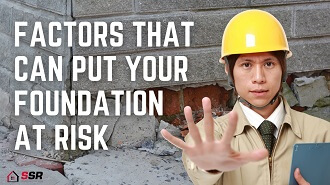FACTORS THAT CAN PUT YOUR FOUNDATION AT RISK

Don’t let foundation problems damage the rest of your 2022!
At SSR, we help our clients understand the causes of their home’s structural damage so they can prevent the same issues from occurring again. When it comes to your home’s foundation, here are some of the most common risk factors that contribute to its damage.
SOIL
The soil around your foundation is an important factor that can affect its structural integrity.
Different types of soil have different compositions and react differently to things such as moisture and dryness. For example, clay soils tend to swell when exposed to too much moisture and shrink during drier weather. This can cause your foundation to constantly shift and settle.
Of course, the type of soil beneath your home also depends on where you live. Knowing the type of soil your foundation is going to be or is built upon can help you understand and prevent future issues.
IMPROPER DRAINAGE
Proper drainage is also another important factor. If your house doesn’t have a proper drainage system, such as gutters, or if your downspouts are not facing the right direction, too much water can affect the stability of your soil and damage your foundation.
PLUMBING LEAKS
Plumbing issues aren’t just annoying when you’re in the bathroom or kitchen. If there’s a big leak in your mainline or the sanitary sewer, the water will seep into the soil and cause your foundation to shift.
TREE ROOTS
Like humans, plants and trees are living creatures, meaning they need nutrients to survive. They get their nutrients and hydration by absorbing them with their roots. To sustain themselves properly, the roots spread out underground, moving the soil and pushing it into whatever is on the other side—including your home’s foundation.
This can cause settling issues, which also lead to cracks in your foundation and walls, especially if you have crawl spaces and basements.
However, cutting down the trees isn’t always the answer. It’s best to call a professional first to investigate.
YOUR HOUSE’S AGE
The size and number of the beams supporting your foundation are important factors in keeping its strength.
Older houses may have stood the test of time, but in most cases, they have slabs with smaller and fewer beams. The less rigid the construction is, the more likely it is to cause foundation problems.
SEASONAL CONDITIONS
Like us, parts of our houses need to adjust to different climates and weather conditions too. In places where seasons cause temperatures to change drastically, foundations are often exposed to different risk factors, such as flooding, dry and cracked soil, and snow.
Wetter seasons can cause the soil to push against your foundation and cause it to crack. On the other hand, dry weather can cause your foundation to sink and winter brings about frost heaving and adfreezing issues.
POOR MAINTENANCE
Like other parts of your home, it’s important to maintain and protect your foundation too. Depending on the weather conditions in your area, your home’s structure, and other factors, you can take steps to secure your foundation and keep it structurally sound.
Here are a few tips to help you get started.
One great way to start is to get experts to evaluate your home. At SSR, we help homeowners stay aware of potential dangers and help them understand, repair, and maintain their home’s structural integrity.
Get a free home estimate today. Call 980-250-2711 or visit www.ssrcarolinas.com/contact



